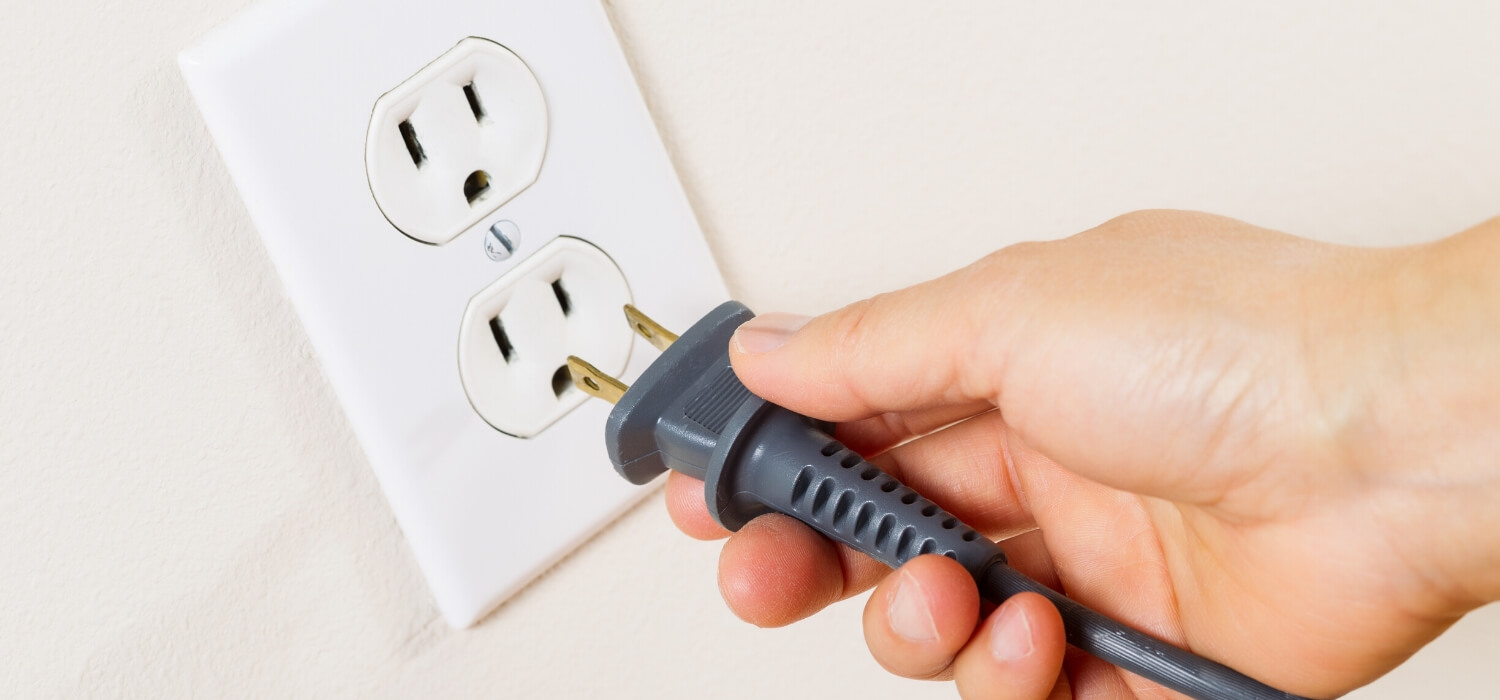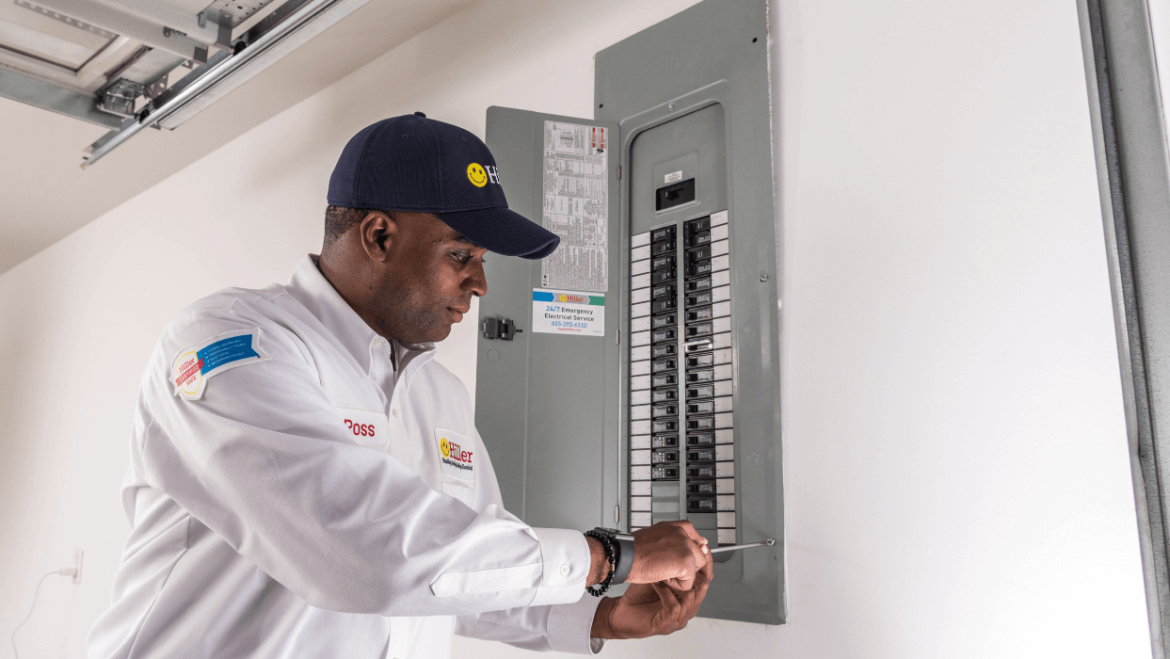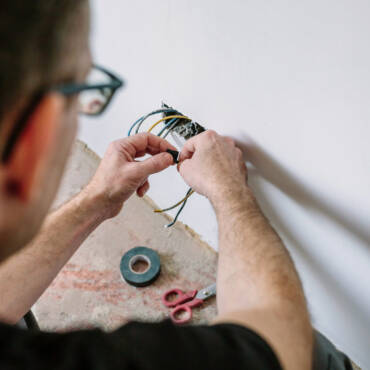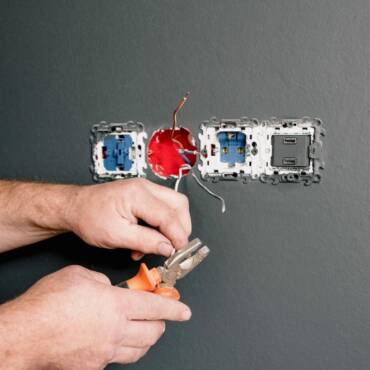Posted October 3, 2025
If you’re a homeowner, the wiring in your home is more than just a network of hidden cables; it’s the lifeblood of your daily activities, the guardian of your family’s safety, and the key to energy efficiency. So, whether you’re building a new home or renovating an existing one, understanding the intricacies of home wiring is not only wise but also essential.
This article is your comprehensive guide to new home wiring. We’ll explore the fundamental concepts of electrical systems, help you find the right electrician, and provide insights into specific considerations. Learn how to plan your home’s wiring effectively, select the right materials, and ensure both safety and energy efficiency.
By the end of this guide, you’ll have the knowledge and confidence to make informed decisions about your home’s wiring, saving you time, money, and potential headaches. Let’s get started.
The Basics of Home Wiring
A home’s electrical system consists of several key elements working harmoniously to power your lights, appliances, and devices. At the core of this system are the electrical panel, circuits, outlets, switches, and the wiring that connects them.
In homes, various types of wiring materials are used to transport electricity. Common options include copper and aluminum wiring. Copper, renowned for its excellent conductivity and durability, is a preferred choice for new installations.
In contrast, aluminum wiring was commonly used in the past but has some safety concerns, so it’s crucial to understand which type is in your home and ensure it meets safety standards.
Safety and regulations play a pivotal role in home wiring. The paramount importance of adhering to electrical codes and safety measures cannot be overstated. Straying from these regulations not only risks safety hazards but can also lead to legal consequences and difficulties with insurance coverage.
Comprehending the local and national electrical codes is vital to ensure your home’s electrical system is not only functional but safe for your family and property.
Selecting a Licensed Electrician
The skills and expertise of an electrician directly impact the safety, functionality, and longevity of your electrical system. Before entrusting your electrical work to anyone, consider the following crucial aspects.
The Significance of Qualifications
Hiring a qualified electrician ensures that your electrical projects are in capable hands. These professionals have undergone rigorous training, possess the necessary knowledge, and are well-versed in the latest industry standards.
Their expertise guarantees that your electrical work is not just done correctly but also safely.
Tips for Finding a Reputable Electrician
Finding the right electrician involves careful consideration. Begin by seeking recommendations from friends, family, or neighbors who have had positive experiences with local electricians.

Additionally, online reviews and testimonials can offer insights into an electrician’s reputation. When you’ve identified potential candidates, conduct interviews to assess their qualifications, communication, and responsiveness.
Licensing and Insurance Matter
Like any city, mandates that electricians hold the appropriate licenses and insurance coverage.
Ensuring that your electrician is licensed guarantees that they meet the city’s stringent requirements and regulations. Insurance, on the other hand, protects you and your property in case of accidents or damages during the electrical work.
Always verify an electrician’s credentials and coverage before any work begins.
Planning Your New Home Wiring
Building a new home is an exciting endeavor, and ensuring the electrical systems are well-planned is crucial for a safe, functional, and convenient living space.
The first step in planning your home’s wiring is to create a comprehensive electrical plan. This plan should be developed in collaboration with a qualified electrician who understands the electrical code requirements.
It outlines the layout of your home’s electrical components, such as outlets, switches, light fixtures, and circuitry. The plan is a visual representation that ensures all electrical needs are met efficiently.
Assessing Your Electrical Needs
To create an effective electrical plan, it’s vital to assess your specific electrical needs. Consider factors like the number of rooms, the type and quantity of electrical appliances and devices you’ll use, and your lifestyle preferences.
This evaluation will help you determine how many outlets, circuits, and switches are required in each room. It’s also the time to consider any future needs, like electric vehicle charging stations or home office requirements.
Positioning Outlets, Switches, and Fixtures
Strategically positioning outlets, switches, and fixtures is essential for convenience and aesthetics. Here are some tips to guide you.
Outlet Placement
Ensure there are an adequate number of electrical outlets in each room. Consider placing them at convenient heights and locations, taking into account furniture arrangement and electronic devices.

In kitchens, include additional outlets for appliances and island countertops. For outdoor spaces, install weatherproof outlets.
Switches
Position light switches near room entrances for easy access. Consider three-way switches in areas with multiple entrances or for staircases. Dimmer switches in living areas can enhance ambiance and energy efficiency.
Light Fixtures
Plan the placement of light fixtures to provide even illumination throughout rooms. Consider the use of recessed lighting for ambient lighting and pendant or chandelier fixtures for focal points. Ensure the fixtures’ design aligns with your interior decor.

Special Circuits
Identify areas that require special circuits, such as those for dedicated appliances like stoves, ovens, and air conditioning units. Ensure these circuits are correctly sized and meet electrical code requirements.
Safety Measures
Install Ground Fault Circuit Interrupters (GFCIs) in areas prone to moisture, like bathrooms and kitchens, and Arc Fault Circuit Interrupters (AFCIs) to prevent electrical fires in bedrooms and living spaces.
Effective planning and positioning of outlets, switches, and fixtures not only enhance your daily living but also contribute to the overall safety and functionality of your new home’s electrical system.
By collaborating with a licensed electrician, you can ensure your electrical plan aligns with local regulations and your unique requirements. This meticulous planning stage will set the foundation for a well-wired home that meets your needs and anticipates future electrical demands.
City Specific Considerations
Wiring your new home comes with its own set of unique considerations, driven by the region’s climate, local building codes, and specific requirements for new construction.
Understanding and adapting to these city-specific factors is crucial for a successful and compliant electrical installation.
Climate Implications
Each city experiences a climate that can range from hot and humid summers to chilly winters. These weather extremes can impact your home’s electrical system.
When planning your wiring, consider the insulation and sealing of electrical boxes to protect against moisture and humidity, especially in areas like basements or outdoor installations.
Proper grounding and surge protection are essential to safeguard your electrical system against storms and lightning, which are not uncommon in the region.
Local Building Codes
Local building codes are a vital part of the city-specific considerations for wiring. Like many municipalities, adheres to the National Electrical Code (NEC) with some local amendments.
These codes are in place to ensure the safety and functionality of electrical systems. Ensure your electrical plan aligns with these codes, and collaborate closely with a licensed electrician who is well-versed in the specific requirements of the area.
Requirements for New Construction
New construction must meet certain requirements to comply with local regulations. This includes permitting, inspection schedules, and adherence to codes related to electrical work.

You’ll need to obtain the necessary permits for electrical installations in your new home. It’s advisable to consult with local authorities or your chosen electrician to navigate this process seamlessly.
Regular inspections will be conducted to ensure your electrical work meets safety standards and local code requirements. Failing to comply with these requirements can lead to delays, legal issues, and safety concerns.
Types of Wiring Materials
When it comes to wiring your new home, one of the critical decisions you’ll face is selecting the right wiring materials. There are several options available, each with its own set of pros and cons.
Making an informed choice is essential to ensure the safety and efficiency of your electrical system.
Copper Wiring
Copper is known for its excellent electrical conductivity, durability, and resistance to corrosion. It has a long lifespan, making it a reliable choice for electrical wiring. Copper wiring is also easy to work with during installations.
It tends to be more expensive than some alternative materials. However, its longevity and performance often justify the cost.
Aluminum Wiring
Aluminum is a cost-effective option and is lighter than copper. It can handle high electrical loads and is used in many homes.
Aluminum wiring is more prone to oxidation and requires special connectors and maintenance to prevent safety issues. Homes with aluminum wiring may need periodic inspections and maintenance to ensure safety.
Copper-Clad Aluminum (CCA) Wiring
CCA wiring combines the conductivity of copper with the affordability of aluminum. It’s a suitable alternative in situations where cost is a concern.
CCA wiring may not be as durable as pure copper and can be less effective in high-heat situations. It’s important to choose CCA wiring that meets recognized safety standards.
Non-Metallic Sheathed Cable (NM)
NM cable, often referred to as Romex, is a popular and cost-effective wiring choice for residential applications. It is easy to work with and install.
It may not be suitable for some industrial or high-heat applications. The cable sheath is typically made of plastic, which can be less durable in extreme conditions.
Armored Cable (AC)
AC wiring consists of insulated wires enclosed in a flexible metal sheath, offering enhanced protection against physical damage. It is suitable for both residential and commercial applications. AC wiring can be more challenging to install than NM cable, and it may be costlier.
Fiber Optic Wiring
Fiber optic cables are primarily used for high-speed data transmission and are immune to electromagnetic interference. They are incredibly efficient for networking applications.
They are less common for traditional residential electrical purposes and may not be practical for basic home wiring needs.
Wiring for Safety and Energy Efficiency
Wiring your new home goes beyond merely ensuring functionality; it’s about creating a safe and energy-efficient electrical system.
Let’s delve into safety measures and best practices to prevent hazards and explore ways to optimize energy efficiency, especially in the context of city’s climate.
Proper Grounding
Ensuring your electrical system is properly grounded is a fundamental safety measure. Grounding reduces the risk of electrical shock and fire hazards. An experienced electrician can confirm that your wiring is grounded in compliance with the electrical code.
GFCIs and AFCIs
Install Ground Fault Circuit Interrupters (GFCIs) in areas prone to moisture, like bathrooms and kitchens, to prevent electrical shocks. Additionally, employ Arc Fault Circuit Interrupters (AFCIs) in bedrooms and living spaces to reduce the risk of electrical fires caused by arc faults.
Regular Inspections
Periodic electrical inspections are essential to identify potential issues or wear and tear. A professional electrician can perform these inspections, ensuring that your electrical system remains safe and up to code.
Surge Protection
The climate can bring thunderstorms and lightning. Protect your electronic devices and appliances by installing surge protectors to safeguard against power surges caused by lightning strikes.

Electric Water Heater Wiring Requirements
When installing an electric water heater, it’s crucial to adhere to specific wiring requirements. Ensure the proper gauge of wiring and breaker size to match the water heater’s electrical demands. This not only ensures safety but also maximizes energy efficiency.
Find Help With Your Home Today
Your new home wiring is more than just a network of hidden cables. It’s the foundation of your daily life, ensuring safety, convenience, and efficiency.
Hiller is the premier choice for homeowners. They specialize in plumbing, heating, cooling, and electrical services, providing top-notch solutions for all your home needs. We’ve been helping homeowners since 1990.
Contact us today!

Daily Promotion
$99 Electrical Inspection
Seasonal safety starts with a $99 electrical inspection.
Get Promotion
Whether you require installation, repair, or maintenance, our technicians will assist you with top-quality service at any time of the day or night. Take comfort in knowing your indoor air quality is the best it can be with MOE heating & cooling services Ontario's solution for heating, air conditioning, and ventilation that’s cooler than the rest.
Contact us to schedule a visit. Our qualified team of technicians, are always ready to help you and guide you for heating and cooling issues. Weather you want to replace an old furnace or install a brand new air conditioner, we are here to help you. Our main office is at Kitchener but we can service most of Ontario's cities
Source link



